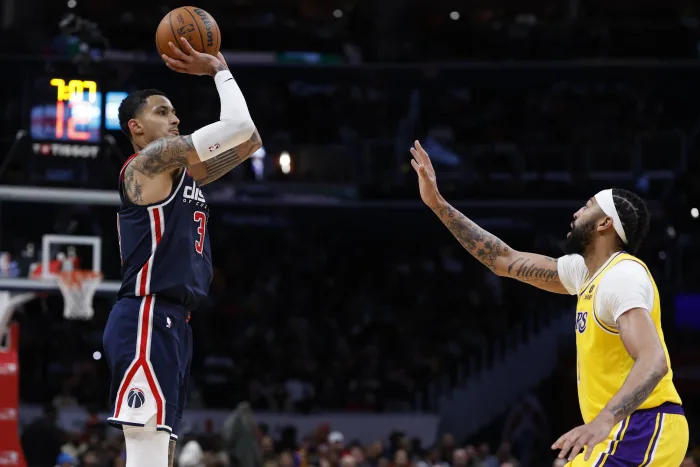3 Pros and 3 Cons of the Lakers Potentially Trading for Kyle Kuzma
Could Kyle Kuzma’s return be the spark the Lakers need? Here’s a look at three advantages and three drawbacks of a possible trade.
Though there’s no confirmed news of Kyle Kuzma heading back to the Lakers, the idea has appeal given their current roster needs. Since leaving the Lakers’ 2020 title-winning team, Kuzma has grown with the Washington Wizards, posting career-high averages of 22.2 points, 6.6 rebounds, and 4.2 assists per game, showing he’s more than just a role player.
At 29, Kuzma is in his prime, and his three-year contract decreases in value, making him a feasible trade target for teams seeking to boost their lineup without a heavy financial commitment. His familiarity with the Lakers organization could make a seamless fit. Here’s a breakdown of the pros and cons of a Kuzma reunion in L.A.
Pros of the Deal
Familiarity with the Lakers
One big plus for bringing Kuzma back is his familiarity with the team, the culture, and the Los Angeles spotlight. Kuzma spent four seasons with the Lakers from 2017 to 2021, playing alongside LeBron James and Anthony Davis and helping win the 2020 championship. This experience taught Kuzma mental toughness and how to handle high-pressure expectations, which could allow him to quickly adjust and play a crucial role for the team.
With his understanding of the Lakers organization, Kuzma could reintegrate easily and contribute immediately. His previous chemistry with LeBron and Davis might also help him step into a role that supports the team’s core, making him an asset as the Lakers aim for a deep playoff run.
The Wizards are Focused on a Rebuild
The Wizards are in full rebuild mode, having recently endured a 15-67 season, the worst in franchise history. They’ve added young talent like second-overall pick Alex Sarr and guards Bub Carrington and Kyshawn George, who will need time to develop. As a 29-year-old veteran, Kuzma doesn’t quite fit the Wizards’ long-term plans.
In this context, Kuzma’s experience and skillset may be better suited to a team aiming for immediate success, like the Lakers. Given Washington’s emphasis on youth, Kuzma is a valuable trade piece, and his decreasing three-year contract makes him an affordable option for teams that want a scoring forward but prefer future salary flexibility.
This situation means the Wizards might consider trading Kuzma at a discount, opening up minutes for their younger players and giving them more assets to fuel their rebuilding process.
Kuzma’s Dependable Durability
One of the biggest reasons the Lakers could consider Kuzma is his reliability. While Lakers stars like LeBron James and Anthony Davis frequently miss games, Kuzma has been consistent, playing the majority of games each season and averaging over 20 points per game in Washington.
Additionally, Kuzma’s contract is reasonable compared to recent Lakers deals like Rui Hachimura’s $17 million yearly salary and Jarred Vanderbilt’s $48 million extension. Kuzma’s contract decreases from $23.5 million to $21.5 million and finally $19.4 million, offering the Lakers cap flexibility and a steady scorer accustomed to the demands of playing in L.A.
Adding Kuzma’s stable presence and scoring could strengthen the Lakers’ depth, especially as they prepare for the intensity of the playoffs.
Cons of a Potential Deal
High Trade Cost
Acquiring Kyle Kuzma could be costly for the Lakers, possibly requiring a package with players like D’Angelo Russell, Jarred Vanderbilt, and a first-round pick. This would deplete the Lakers of valuable rotation players and future assets. Russell, who earns $18.7 million, is a key ball-handler and scorer, while Vanderbilt’s $48 million contract extension makes him a budget-friendly defensive asset.
Investing these assets in Kuzma could limit the Lakers’ flexibility for future trades. If bigger stars like Trae Young or Zach LaVine become available, the Lakers might struggle to secure them after using a first-round pick and key players on Kuzma. While Kuzma would offer immediate offense, his acquisition cost could hinder the Lakers’ roster options and future potential to bring in another high-level talent.
Inconsistent 3-Point Shooting
A key drawback with Kuzma is his lack of consistency from the three-point line. This season, he’s shooting just 27.8% from deep, below the league average. Last season wasn’t much better, with only 33.6% shooting from beyond the arc, while his career average sits around 33.7%. During his previous Lakers tenure, Kuzma’s long-range shooting also wavered, connecting on just 33.8%.
The Lakers depend on floor spacing to allow LeBron and Davis room to drive to the basket, so another inconsistent shooter could cause spacing issues. Kuzma’s spotty shooting could clog lanes for the team’s stars, complicating offensive flow. Given his three-point struggles, the Lakers might need to reconsider if Kuzma’s profile aligns with their needs, especially at the cost of valuable assets.
Kuzma’s Desire for a Lead Role
Since leaving L.A., Kuzma has embraced a bigger role with the Wizards, growing from a supporting player to a primary scorer. He averaged 22.2 points last season and has expressed a desire to be a lead contributor rather than the third or fourth option. This could present challenges if he returns to the Lakers, where LeBron, Davis, Austin Reaves, and D’Angelo Russell are the main offensive options.
Kuzma’s preference for a larger role may not align with the Lakers’ current structure. Balancing his desire for more offensive involvement with the established hierarchy could disrupt team chemistry. For a team centered on maximizing LeBron and Davis’ minutes, Kuzma’s need for volume scoring may clash with the Lakers’ game plan, complicating his integration into the lineup.
